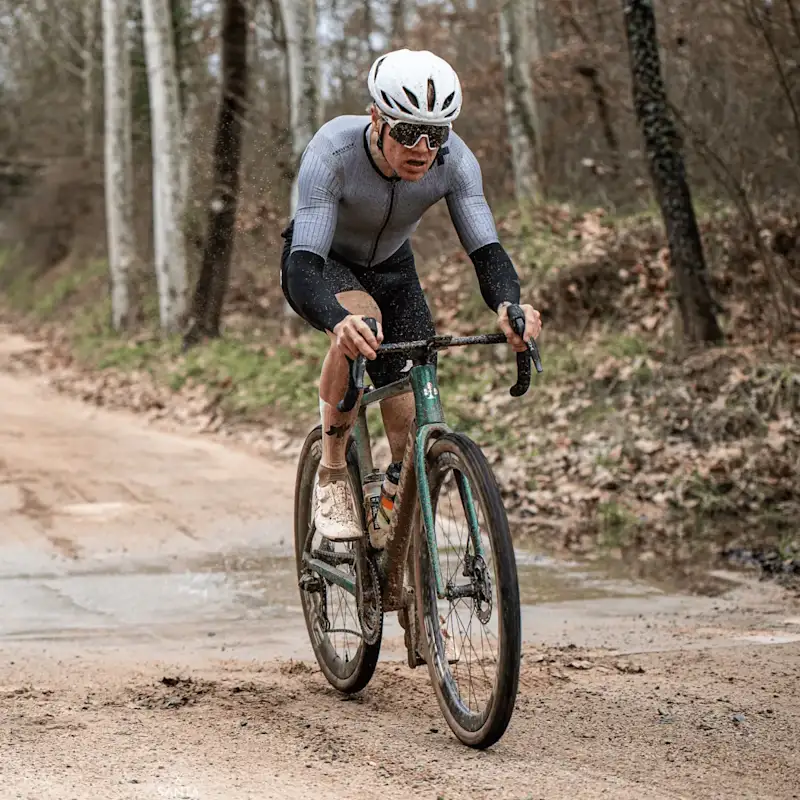
Jason Osborne
Santa Vall Day 1
Jason's headline numbers
Jason's strategy
Fueling
Carbohydrate is the main fuel you burn when racing. Failing to fuel properly is a leading cause of underperformance in longer races.
Jason started his day with a rice-based carb-rich breakfast along with some traditional German snacks (1 x packet of Haribo sweets) to ensure he began the race with fully topped up glycogen stores. During the race, he planned to carry four 500ml bidons, each filled with 120g carb in the form of Carb Only Drink Mix. Unfortunately, Jason dropped one of these bottles and missed a pick up at the chaotic feed zone, only securing one of his replacement bottles along with a third bottle from a friendly soigneur from another team. Although Jason missed some of his planned intake, he was still able to achieve the highest ever recorded carb intake in our Athlete Case Study Database at ~155g/h. Although this falls well-above the current recommendations, we are seeing elite cyclists with enormous rates of energy utilisation consuming well over 90g/h without issue and often to their benefit. This is especially true for stage races where repeat performance is crucial to success and increased carb intake can enhance recovery and next day performance following exhaustive exercise. Jason was off the front for the majority of the race, but unfortunately, he couldn’t come away with the win due to some classic gravel equipment issues despite feeling like he had enough energy and form on the day to do so.
Hydration
Taking on board an appropriate amount of fluid and sodium is essential to maintaining blood volume and supporting the cardiovascular effort needed to perform on race day.
Whilst the absolute amount of sodium and fluid consumed per hour is important, it’s critical to consider these in relation to each other. This is known as 'relative sodium concentration' and it’s expressed in milligrams per litre (mg/L). How much sodium you’re taking in per litre of fluid is more important than the absolute amount taken in per hour.
Sweat sodium concentration (mg/L) is largely genetically determined and remains relatively stable. Knowing how salty your sweat is enables you to replace a good proportion of your sweat losses, which can range from 200-2,000mg/L.
Whilst Jason’s losses are on the moderate side, getting his hydration strategy right is still important if he wants to perform at his best.
Learn moreOne of the replacement bottles he secured after missing two of his own came from a helpful soigneur. Even though he didn’t know what product was contained in the bidon, this was a small risk Jason decided to take, as he typically doesn’t have a sensitive stomach. After tasting it, he noted it was not very concentrated and was therefore unlikely to cause him issues and he’d benefit from having the fluid on board. With this being such a short and cool race, ~638ml per hour was likely sufficient to maintain performance throughout. Jason noticed some small cramps, and although he suggests these did not heavily impact his performance, we would recommend he preloads with a strong electrolyte drink before his races to start optimally hydrated. Additionally, he should consider including some electrolytes in his drinks during races to ensure he stays more optimally hydrated throughout, and help reduce the risk of any further cramping. Focusing on preloading with electrolytes and replacing his losses during exercise will become more crucial as his races get longer and occur in warmer conditions, when net sodium losses increase with higher sweat rates and exercise duration.
Caffeine
Beyond the Three Levers of Performance (carb, sodium and fluid), caffeine is one of only a few substances that is proven to improve performance for most endurance athletes as it can help stave off mental and physical fatigue.
Like any pro cyclist, Jason loves his pre-ride coffees. Sometimes, those sensitive coffee scales can also be used for measuring out your Carb Only Drink Mix to the gram like he does… Jason had two flat whites before this race but didn’t top up with any more caffeine. This meant that he was below the guidelines for caffeine usage and could benefit from additional doses before and during his race to increase focus and mask fatigue over longer races.
How Jason hit his numbers
Here's everything that Jason ate and drank on the day...
Jason's weapons of choice
Final thoughts
Jason's full stats
Data Confidence?
There is an adequate level of accuracy in the data collected and the numbers reported. The athlete manages to recall what they ate and drank including most specifics (brands flavours quantities plausible estimations of volumes). However there are estimations made within the data which affect the overall confidence level in the data reported.